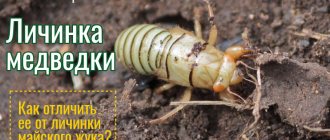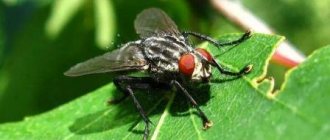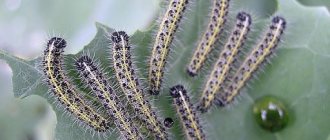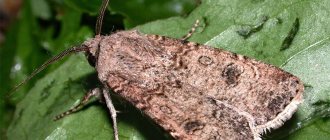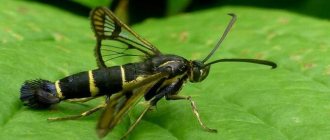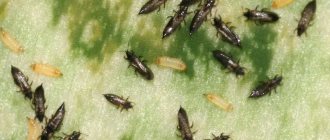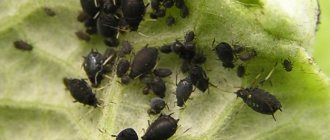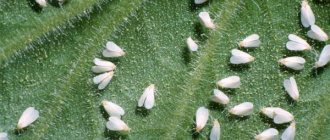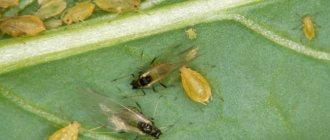An unremarkable butterfly - the cabbage cutworm - has long chosen human fields and vegetable gardens as a breeding ground, and agricultural crops as a source of food for voracious caterpillars. This pest is distributed throughout the European continent and is well known to people. Therefore, today there are effective ways to combat it.
Cabbage cutworm: description, appearance, life cycle
The cabbage armyworm (Mamestra brassicae) is a butterfly of the moth family, order Lepidoptera. The body length is 19-23 mm, its wingspan is 40-50 mm.
The front wings of the cutworm are gray-brown in color with a pattern of curved yellow lines; the leading edge has dark spots and a pattern with a double row of zigzags. The hind wings are darker: brown or gray.
The lifespan of the female is 2-3 weeks.
The mating period begins 2-3 days after the butterflies emerge from the pupae. The female lays eggs on the underside of leaves in batches. One clutch can contain 20-150 eggs. The fertility of females is 600-2700 eggs.
Armyworm eggs are slightly oblong in shape and white in color, their diameter is 0.6-0.7 mm. The egg stage lasts 4-12 days.
The caterpillar develops in 24-50 days, depending on air temperature and soil moisture. The larva molts five times and goes through six instars. An adult caterpillar is 5 cm long. It has 16 legs. The color of the larva can vary: from light green to dark brown. There are black stripes on the back.
Armyworm larvae feed on cabbage, legumes, beets, lettuce, onions, etc. At the first instar, they feed on the leaves from below, leaving the upper part intact. In the second and third instars, the caterpillars gnaw holes, and in older instars they eat up the leaves almost completely, leaving only large veins.
After the caterpillar stage comes the pupa stage. The larvae of the first generation pupate at the end of June, and the second - in September-October. The pupa overwinters in the ground at a depth of 10-25 cm. The length of the pupa is 19-24 mm.
When the air temperature warms up to 16-17°C, that is, at the end of spring - at the beginning of summer, a butterfly emerges from the pupa.
Cabbage pests: aphids
Aphids are a fairly common and serious problem. The insect loves to suck out the sap of the plant, depriving it of nutrition. As a result, the heads of cabbage look ugly and lose their presentation and nutritional value. When attacked by aphids, the vegetable grower will notice damaged and twisted foliage that has unnaturally changed its color, as shown in the photo.
Plants are at risk from larvae and adult insects. Females come in two types. These can be white, wingless insects or winged, brown in color. They migrate from bed to bed without any problems, lay eggs and infect new, succulent plants.
According to experienced farmers, when aphids attack, the harvest becomes poorer than expected. The reason is that the insect depletes the plant's strength, it cannot develop properly and form a large head. Therefore, even if aphids are not detected during regular inspection, it is worth taking time for prevention. For this purpose, the following activities are carried out:
- In autumn, all plant debris is collected for destruction.
- It is worth eradicating all wild cruciferous crops from the site.
- Spraying plantings with garlic infusion repels aphids.
In the photo there is a cabbage fly and its larvae
However, timely prevention does not provide 100% protection. farmers tend to regularly inspect cabbage for aphids. If individuals are detected, you need to begin an active fight for the harvest. Leaves can be wiped with a soft cloth soaked in soapy water. However, for large plantations it is impossible to perform this simple procedure. In this case, spraying is the only right solution. The drugs “Iskra”, “Decis” or “Karbofos” have proven their effectiveness.
The cruciferous flea beetle is another uninvited guest in cabbage beds. Insects are so voracious that in just a few days they can destroy a farmer’s many days of work. Effective measures to combat cruciferous flea beetles will help destroy them quite quickly.
Why is cabbage cutworm harmful?
Butterflies are safe for the harvest: adults feast on nectar at dusk. But the cabbage moth caterpillar is quite voracious and eats cabbage, and it can just deprive the harvest.
The cabbage cutworm larvae of the third instar feed on the pulp of the leaves, while the larvae of the fourth and fifth instars eat the cobs, forming tunnels in them. In addition, the caterpillars deposit excrement in the cabbage, which leads to rotting of the heads of cabbage.
If you do not fight the cabbage cutworm, you can completely lose the harvest.
The cabbage cutworm feeds not only on cabbage, it can also feast on beets, poppy seeds, corn, legumes, sunflowers, tobacco, sesame seeds, sage, radishes, cloves, chrysanthemums, potatoes, tomatoes, carrots, flax, buckwheat, etc. It can cause harm fruit trees and ornamental plants.
Depending on the region, the moth can be found at different times: in the center and northwestern part of Russia, butterflies can be seen in early June, and in the Volga region and the North Caucasus - already in May. For this reason, it is especially dangerous for the southern regions: the armyworm manages to degenerate in two generations, which means that the caterpillars appear twice per season.
Cabbage cutworm, caterpillar, green form
Cabbage cutworm, caterpillars, dark form
Cabbage cutworm, caterpillars, various forms
Cabbage pests
In addition to general pests, seedlings and adult cabbage plants are harmed by special insects that prefer cabbage leaves. It is worth noting that this is a fairly large group of pests, the fight against which is particularly difficult - after all, it is often not possible to detect damage in a timely manner, because bugs and fleas get inside the head of cabbage.
Babanukha (cabbage leaf beetle)
Control measures: timely removal of weeds (especially wild radish and mustard), early digging of the soil in the spring, cleaning the garden of debris and plant debris in the fall.
Cabbage fly
The gray fly is very small in size - only 6 mm, but its voracious larvae, which hatch in the ground from eggs laid by females, are capable of completely destroying the root system of cabbage seedlings and young plants. The female specially lays a clutch near the roots of the cabbage; the hatched offspring immediately begin to eat the young roots, as a result of which the plants die.
An infusion of fresh burdock leaves helps repel pests.
Cabbage whites
A small, inconspicuous, gray-white butterfly that lays eggs on the underside of cabbage leaves is called the cabbage white. It is not the butterflies themselves that harm the leaves of plants, but their larvae that hatch from eggs. They are so voracious that they can leave only rough veins from the leaves.
Control measures: spraying infected plants with wormwood infusion, periodically inspecting cabbage and destroying clutches manually. Planting beds with cabbage with carrots and dill, which will attract insects that eat the eggs and larvae of cabbage whites.
Cabbage moth
Another butterfly whose larvae harm seedlings and young cabbage plants. The body of the butterfly is small, the color of the wings is gray with an unclear pattern. The butterfly lays eggs on cabbage leaves, after which the caterpillars that emerge from the eggs begin to eat them with appetite. After about a month, the caterpillars turn into pupae, but by this time the cabbage leaves turn into a sieve - the pests gnaw through holes in the body of the cabbage leaf.
Preventive measures: early planting of seedlings, timely removal of garbage and weeding. You can mechanically destroy the cabbage moth by luring the pest to the light.
Cabbage scoop
Gray butterfly with transverse darker stripes on the wings. The laid eggs hatch into voracious white caterpillars that eat cabbage and beet leaves, lettuce, and peas.
Measures to prevent the spread of the pest are identical to the fight against cabbage moth. Spraying garden plants with an infusion of red hot pepper helps.
Cabbage has many pests, but keeping the garden clean and timely destroying plant residues, as well as removing weeds from the garden, will help prevent them from spreading into the garden beds.
https://www.syl.ru/article/205453/new_borba-s-vreditelyami-kapustyi-chem-obrabotat-kapustu-ot-gusenits-tli-bloshek-preparatyi-dlya-borbyi-s-vreditelyami-kapustyi
https://tyfermer.ru/vrediteli-kapusty-foto/
https://abekker.ru/articles/obzor-vreditelej-kapusty
Cabbage cutworm: how to get rid of it on the site?
To get rid of the pest, you can use different methods: collect insects by hand, use pesticides, traps and decoctions. Each method has its own advantages and disadvantages. Let's take a closer look at various ways to get rid of cabbage cutworms.
Mechanical methods of fighting armyworms
The easiest way to reduce pests is by hand picking.
Regularly, every week, it is necessary to inspect the cabbage leaves. All discovered clutches of eggs and larvae must be destroyed. The optimal time for collecting caterpillars is early twilight, when the larvae emerge from their hiding places in search of food.
Manual collection of insects is considered an ineffective method of pest control. It will help reduce the number of armyworms on the site, but it is impossible to completely get rid of them. If you do not use other methods or skip at least a few weeks of collecting pests, the population will completely recover, and all your work will be in vain.
To get rid of cutworm pupae, it is necessary to loosen the soil to a depth of at least 10 cm before winter.
Chemical methods of fighting armyworms
To destroy pests, the most effective method is the use of chemicals.
The following means are suitable for combating armyworms:
- Iskra-M;
- Inta-Vir;
- Sherpa;
- Kinmiks;
- Fas;
- Bankolom;
- Zeta et al.
Insecticides should be sprayed at sunset in calm and rainy weather. Chemicals can be used no more than twice per season.
The use of insecticides must be stopped a month before harvesting cabbage, otherwise there is a risk of fruit poisoning later.
Biological methods of combating armyworm
Using biological agents is a safer way to get rid of pests compared to chemicals.
The following biological agents will be effective against armyworms:
- Lepidocide;
- Bitoxibacillin;
- Fitoverm et al.
Biological products do not harm humans or processed fruits. But their use has its own rules: treatment with biological agents must be completed no less than 5 days before the start of harvest.
Cabbage cutworm, caterpillar and butterfly
How to fight with folk remedies
And although the cabbage cutworm caterpillar in the photo does not cause concern, getting rid of it is not so easy. To achieve maximum effect, it is recommended to use several methods, combining them with each other.
Folk remedies are popular not only because of their effectiveness, but also their harmlessness. Ready-made solutions are safe for human health and plants on the site. The advantage of traditional methods is their accessibility: most components are free or have a low cost.
To catch cabbage cutworms, you can use not only infusions, but also traps. To make them, just stock up on disposable cups or bottles that need to be trimmed, leaving sides 3 cm high. Fill the resulting containers with sweet liquid and hang them 1 m from the ground.
To prepare cabbage scoop syrup, mix 50 g of yeast with 1 liter of water. When the solution has fermented, add 1000 ml of flow and another 3 liters of water. Distribute the finished substance into containers. You can use compote or jam as a sweet liquid.
Important! Insect traps should be refilled with solution periodically. Once every two weeks, the contents of the container must be completely changed.
To prevent insects from escaping from the trap, the cut part of the bottle can be placed back into the container with the neck down.
Hot pepper solution
To use this product, you need to take 100 g of pods, fill them with 1 liter of water and put on fire. Boil the solution for 60 minutes. Cool the resulting remedy for cabbage cutworms, strain, and leave to infuse under the lid for two days.
It is convenient to spray plants against insects using a spray bottle, diluting the liquid in a ratio of 1:10 with water.
Liquid soap with wormwood from cabbage scoop
To obtain a solution, flowering wormwood must be crushed. Fill it with a bucket of hot water. Boil the raw material for 15-20 minutes, and then let it cool for six hours. Add 1 tbsp to the prepared remedy for cabbage cutworms. l. liquid soap. Shake the container with the mixture thoroughly before use.
Ash solution
Mix 200 g of nitrogen fertilizer and tobacco waste with 30 g of melted soap and 15 g of mustard. Pour boiling water over all components of the product, bringing it to 10 liters, and then leave the pan with the contents for one day. The ready-made preparation for cabbage cutworm can be used to treat vegetable crops.
Herbal infusion
Fill the bucket halfway with burdock leaves and compact them tightly. Fill the container to the brim with water. Leave the infusion in this position for 72 hours, and then strain it. It does not need to be diluted with water to use. To prevent the product from rolling off the leaves, it is best to add laundry soap to it.
As a substitute for burdock, you can use chamomile, datura or spurge
Cabbage scoop soda
The emulsion consists of only two components. To obtain it, you need to dissolve a glass of soda in a bucket of water. Spray the plant with the prepared cabbage cutworm remedy.
Dandelion infusion
Add 500 g of raw materials to 10 liters of water. You can use crushed leaves and shoots, roots and flowers. Add 1 tbsp to the resulting solution. l. liquid soap and leave it to sit overnight before use.
Tomato infusion
Chop green tomato stems. Mix them with bitter wormwood. To 10 liters of boiling water you need to add 350 g of the resulting mixture, and then leave all the components to infuse for six hours.
Bird droppings with wormwood
Boil 1 kg of herb in 3 liters of water. Two days before use, add 100 g of bird droppings to the infusion. Dilute the resulting remedy for cabbage cutworms with water to 10 liters, and then use it for its intended purpose.
Step-by-step instructions for fighting
With a cutworm butterfly in the garden
The armyworm and the fight against it have a number of features. Read below on how to deal with cutworms in your garden.
Prediction using pheromone traps. Traps show the exact time of the beginning of butterfly flight and the appearance of caterpillars. Initially, the summer passed during the flowering period of dandelions. But now all deadlines are shifted and extended in time
Therefore, forecasting is very important for timely action. To avoid poisoning plants with chemicals, you should first try to remove the cutworm using folk remedies. Attracting the cutworm's natural enemies - Trichogramma and Bracona. Hang bait traps throughout the garden. If the effectiveness is insufficient, biological products against cutworms are used. If they do not help to completely get rid of the butterflies, use the “heavy artillery”. Control measures for the fall armyworm should include chemical insecticides. At the end of the gardening season, it is worth digging up all the soil deeply, since cutworms overwinter in the soil
After digging, most of the pests die.
Now you know how to get rid of cutworms in your garden. About scoop caterpillars, how to fight further.
With caterpillars
- At the beginning of the season, dig the soil as deep as possible to reduce the number of overwintering pests.
- When planting, use alternation of different plant crops.
- Be sure to eliminate weeds that serve as the initial food supply for the larvae.
- When the first single specimens appear, they begin to be collected manually.
- If the number of caterpillars begins to increase, a means is selected to destroy them.
It is recommended to use gentle drugs from the group of folk or biological ones.
If they are ineffective, biological products are replaced with chemical insecticides. After harvesting, deep digging of the site is used again.
The cutting armyworm methods for dealing with it are below.
With a gnawing scoop
- The main measure to reduce the number is digging up the soil to a depth of at least 25 cm. This is carried out twice a season - before planting and after harvesting. This procedure will get rid of most existing pests in the caterpillar and pupa stages;
- After planting the plants, they regularly loosen the soil between the rows and beds with a thorough inspection. All discovered caterpillars are immediately removed and destroyed;
- eliminate weeds not only in the garden, but also around the entire site;
- lure the gnawing moth butterfly into traps from a fermenting drink - kvass, molasses, beer, compote;
- To destroy the larvae that live in the ground, it is necessary to use soil insecticides.
Some experienced gardeners use a tank mixture of the drug (1/2 of the required dose) with urea (100 g per bucket of water).
Control measures for cotton bollworm are slightly different, more on that below.
With cotton boll
The cotton bollworm is a quarantine pest against which special measures are taken. How to deal with it further.
Quarantine procedures include:
unrelenting control over purchased seedlings, seedlings and bushes
Particular attention should be paid to cotton, chrysanthemums, tomatoes, corn, roses and eggplants. But remember that the cotton bollworm is an almost omnivorous pest; if a pest is detected, the entire batch of purchased sprouts is fumigated, as well as the container; widespread and active use of pheromone traps.
Photos of the scoop and the fight against it, see below.
How to deal with the scoop? The subsequent struggle is:
- In compliance with all rules of agricultural technology in closed greenhouses and in open areas.
- Constant monitoring and identification of pests at all stages of development.
- Thorough and timely removal of weeds and their subsequent burning.
- Preventive treatment of suspicious plants with chemical insecticides.
Read on for potato bollworm control measures.
Sources
- https://BeetleStop.ru/kapustnaya-sovka/
- https://FermoVed.ru/kapusta/sovka-mery-borby.html
- https://vreditel-stoi.ru/ogorod/kapusta/kapustnaya-sovka.html
- https://www.sadovniki.info/?p=2496
- https://vreditel-stoi.ru/ogorod/tomatyi/sovka-na-tomatah.html
- https://www.glav-dacha.ru/kapustnaya-sovka-metody-borby/
- https://mojateplica.ru/vrediteli-kapusty/
- https://rusfermer.net/ogorod/vrediteli/sovka-babochka/borba.html
Morphology
Imago . A butterfly with a body length of 19–23 mm. [5] Wingspan – 40–50 mm. The forewings are dark brown with dark transverse lines. The kidney-shaped spot is surrounded by white or partially white. The submarginal line is yellow-white with two teeth in the shape of the letter M. The hind wings are gray, darker at the edges. [1]
Sexual dimorphism Individuals of different sexes differ in the structure of their genital organs. [10]
The egg is yellowish-white with 32–38 radially directed ribs. Diameter – 0.6–0.7 mm. [1]
The larva (caterpillar) , like all representatives of the noctuid family, has five pairs of abdominal legs equipped with single-tiered or double-tiered hooks located on the sole in a medial row. [8]
Length – 35–40 mm. The color is variable - from grayish-green to dark brown or almost black. On the dorsal side there is a pattern of dark spots in the form of a herringbone, which is especially well expressed on the last segments of the abdomen. The sides of the body are yellowish with light stripes. [1]
The pupa is 19–24 mm long, the integument is red-brown. The cremaster has two long touching projections ending in a flattened club. [1]
Phenology of development (in days)
Babanukha
Babanukha is a dark greenish insect with brownish legs. The insect eats almost all varieties of plants, including cabbage. The leaf beetle waits out the winter under fallen leaves, in manure granules.
In early June, this beetle leaves its wintering site and begins to eat cabbage leaves. Females are able to form depressions in cabbage leaves, in which eggs can later be found.
To escape from this type of pest, use the following:
- painstakingly destroy all traces of plants during the harvesting process;
- get rid of unnecessary plants;
- do not leave radishes and mustard to grow;
- plant seedlings early;
- in the autumn, dig up the ground in the area with seedlings.
Development
Imago . The emergence of butterflies begins in late spring or early summer. In a single-generation zone, butterflies emerge in June. [6]
To lay eggs, females need additional nutrition on flowering vegetation. The lifespan of a female is 2–3 weeks. [1]
Mating period . Mating takes place 2–3 days after departure. The next day, the females begin to lay eggs, placing them on the underside of the leaves in one layer of 20–150 eggs per clutch. The fertility of the female is from 600 to 2700 eggs. [1] The masonry looks like an irregularly shaped spot. [6]
Egg . The embryo develops within 4–12 days. [1]
Phenology
Phenology of development of the cabbage cutworm. Corresponds to the Southern regions of the Russian Federation, Moldova, Ukraine, etc. According to: [2]
The larva (caterpillar) develops from 24 to 50 days, depending on the temperature and humidity of the air and soil. The caterpillar molts five times and goes through six instars. In the first instar, the caterpillars skeletonize the leaves from below, leaving the epidermis of the upper side intact; in the second and third instars, they gnaw out through holes. At older ages, the leaves are eaten almost completely, leaving only the largest veins. When developing on cabbage, caterpillars of middle and older ages penetrate cabbage heads, making winding passages in them, which are subsequently filled with caterpillar excrement. This leads to rotting of the heads of cabbage. Caterpillars developing on beets damage the leaves of the plant and the upper parts of the roots. Poppy seeds are damaged, while corn leaves and grains on the cob are damaged. During mass reproduction, they climb bushes and trees, damaging the fruits and leaves of apple trees and bunches of grapes. [1]
Doll . Caterpillars of the first generation pupate at the end of June, the second - in September-October in earthen cocoons. [1] Pupae overwinter in the soil. [6]
Imago . The flight of second generation butterflies is observed from the second half of July to the beginning of September. [1]
Features of development . The cabbage cutworm is a moisture-loving insect. Most often found in areas with high humidity, especially in river floodplains. An increase in numbers is observed with a combination of warm, moderately humid weather, the presence of flowering vegetation during the flight of butterflies and food plants for caterpillars. Low air humidity causes the death of caterpillars, and the absence of flowering nectar plants causes a sharp decrease in the fertility of butterflies. [1]
Overwintering pupae are able to withstand prolonged flooding. [6]
The number of generations per season depends on the climate of the habitat. Thus, in the mountains of the northern part of the range only one generation develops, in the southern parts of the range - two or three. [6]
Maliciousness
After hatching from the egg, cabbage cutworm larvae are constantly in need of food, so they cause great damage to the cabbage crop by devouring its juicy leaves, rich in minerals and fiber.
- young caterpillars eat large holes in the leaves, depriving them of their marketable appearance;
- adult caterpillars eat up the leaf completely - only the veins remain;
- they climb inside the fruit, gnaw out the stalk completely (outwardly the cabbage is whole and fresh, but when cut it turns out to be empty);
- contaminate the fetus with excrement, causing its destruction.
Insects penetrate inside the plant by gnawing small holes. They gnaw out the fruit gradually as it grows. Cabbage damaged by the cabbage cutworm loses all its beneficial properties and should not be eaten.
The armyworm is a polyphagous pest, but plants of the cruciferous (cabbage) and goosefoot (beets, spinach) families suffer most from it. In addition to cabbage, beets and spinach, the larvae damage potatoes, tomatoes, radishes, rhubarb, leaves of fruit trees, flowers and leaves of chrysanthemums and carnations. If you do not start fighting the pest in a timely manner, you may lose your harvest.
